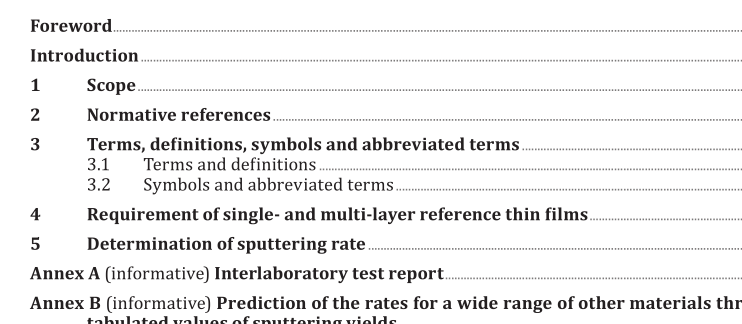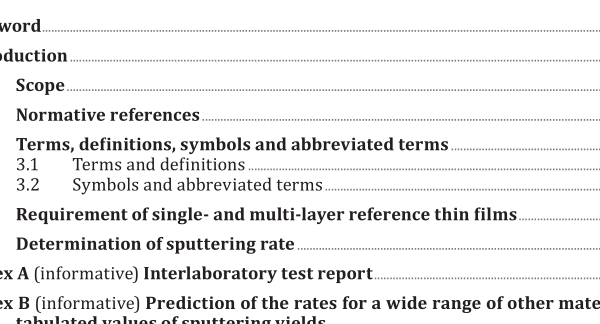ISO 17109:2022 pdf download – Surface chemical analysis — Depth profiling — Method for sputter rate determination in X-ray photoelectron spectroscopy, Auger electron spectroscopy and secondary-ion mass spectrometry sputter depth profiling using single and multi-layer thin films.
1 Scope This document specifies a method for the calibration of the sputtered depth of a material from a measurement of its sputtering rate under set sputtering conditions using a single- or multi-layer reference sample with layers of the same material as that requiring depth calibration. The method has a typical accuracy in the range of 5 % to 10 % for layers 20 nm to 200 nm thick when sputter depth profiled using AES, XPS and SIMS. The sputtering rate is determined from the layer thickness and the sputtering time between relevant interfaces in the reference sample and this is used with the sputtering time to give the thickness of the sample to be measured. The determined ion sputtering rate can be used for the prediction of ion sputtering rates for a wide range of other materials so that depth scales and sputtering times in those materials can be estimated through tabulated values of sputtering yields and atomic densities. 2 Normative references The following documents are referred to in the text in such a way that some or all of their content constitutes requirements of this document. For dated references, only the edition cited applies. For undated references, the latest edition of the referenced document (including any amendments) applies. ISO 14606, Surface chemical analysis — Sputter depth profiling — Optimization using layered systems as reference materials 3 Terms, definitions, symbols and abbreviated terms 3.1 Terms and definitions For the purposes of this document, the following terms and definitions apply. ISO and IEC maintain terminological databases for use in standardization at the following addresses: — ISO Online browsing platform: available at https:// www .iso .org/ obp — IEC Electropedia: available at https:// www .electropedia .org/ 3.1.1 upper plateau region exhibiting intensities higher than 95 % of the maximum intensity of the characteristic signal for that layer and covering more than half the thickness of that layer 3.1.2 lower plateau region exhibiting intensities lower than the minimum intensity plus 5 % of the maximum intensity of the characteristic signal for that layer and covering more than half the thickness of that layer
4 Requirement of single- and multi-layer reference thin films 4.1 The thickness of each layer in multi-layer thin films and the thickness of single-layer thin films shall be sufficiently thicker than the sum of the projected range of the sputtering ions and the information depth of the analytical method, so that an upper plateau and a lower plateau shall be obtained for each layer in sputter depth profiling. The projected range can be simply calculated using SRIM code which is available from http:// www .srim .org [1] . NOTE Sample rotation during ion sputtering is shown to reduce surface roughness development especially of polycrystalline films [2] leading to sharper interfaces and a better estimate of sputtering rates.
ISO 17109:2022 pdf download – Surface chemical analysis — Depth profiling — Method for sputter rate determination in X-ray photoelectron spectroscopy, Auger electron spectroscopy and secondary-ion mass spectrometry sputter depth profiling using single and multi-layer thin films






